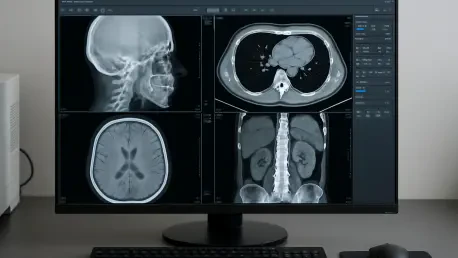Setting the Stage for a Market Shift
In a healthcare landscape increasingly driven by accessibility and efficiency, the outpatient imaging sector stands out as a critical growth area, valued at over $2 billion globally. This dynamic market, fueled by rising demand for decentralized care in clinics and smaller facilities, has caught the attention of industry giants. On November 21, 2025, GE HealthCare made a bold move by announcing a $2.3 billion cash acquisition of Intelerad, a leading provider of cloud-based medical imaging software. This deal isn’t just a financial transaction; it’s a strategic pivot that could redefine competitive dynamics in outpatient care technology. Why does this matter? The merger signals a broader industry trend toward integrating advanced software solutions with traditional hardware, promising to reshape how healthcare providers manage imaging outside hospital walls.
This market analysis aims to dissect the implications of this acquisition, focusing on current trends, financial impacts, and long-term projections for the outpatient imaging sector. By examining the synergies between GE HealthCare’s established equipment expertise and Intelerad’s innovative software platforms, a clearer picture emerges of how this deal could influence market share and technological advancements. The following sections will explore key patterns in healthcare delivery, data-driven insights into the financial rationale, and forecasts for how this move might catalyze further industry consolidation.
Deep Dive into Market Trends and Projections
Outpatient Care: The Rising Epicenter of Healthcare Delivery
The healthcare industry has witnessed a significant shift toward outpatient care, driven by cost pressures on hospitals and patient preference for convenient, accessible services. Clinics, ambulatory surgery centers, and smaller facilities are increasingly handling a larger share of medical imaging needs, creating a demand for scalable, user-friendly technologies. This trend is not merely a passing phase; market estimates suggest that the outpatient imaging segment will continue to grow at a robust pace through at least 2027, fueled by aging populations and the push for early diagnostics outside traditional inpatient settings.
GE HealthCare’s decision to acquire Intelerad aligns directly with this momentum. While historically focused on high-end hospital equipment like MRI and CT scanners, the company recognizes the need to diversify its portfolio to capture recurring revenue streams from software-as-a-service (SaaS) models prevalent in outpatient environments. Intelerad’s established presence in this space, with its cloud-based platforms for managing and sharing medical images, provides an immediate entry point into a market segment that prioritizes agility over capital-intensive hardware.
This shift also reflects broader economic realities. As hospital budgets tighten under regulatory and reimbursement constraints, outpatient facilities offer a more cost-effective alternative for both providers and patients. The acquisition positions GE HealthCare to address these evolving needs, potentially setting a benchmark for how legacy equipment manufacturers can adapt to decentralized care models without losing their core strengths.
Technological Synergies: Merging AI with Cloud-Based Solutions
A pivotal aspect of this acquisition lies in the technological convergence it enables, particularly between artificial intelligence (AI) and cloud-based imaging systems. GE HealthCare has been investing in AI to enhance diagnostic precision and streamline clinical workflows, a capability that could amplify the functionality of Intelerad’s software platforms. The potential to integrate advanced algorithms with SaaS offerings promises to deliver faster, more accurate imaging analysis, a critical advantage in outpatient settings where speed and efficiency are paramount.
However, the path to seamless integration is not without obstacles. Combining complex AI systems with existing software requires substantial research and development efforts, alongside careful attention to user experience to prevent disruptions for healthcare providers. Despite these challenges, the market outlook remains optimistic, with projections indicating that AI-driven imaging tools could penetrate a significant portion of outpatient facilities by the end of this decade, driven by demand for data-driven decision-making.
This technological edge also positions the combined entity to stand out in a competitive field. Rivals in the medical imaging space are similarly exploring digital solutions, but the scale and complementary nature of this merger could accelerate adoption rates among clinics and smaller providers. The focus on cloud infrastructure further taps into a growing preference for interoperable systems, where imaging data can be shared effortlessly across care settings, aligning with the industry’s digital transformation agenda.
Financial Metrics and Market Expansion Opportunities
From a financial perspective, the $2.3 billion acquisition offers immediate and long-term benefits for GE HealthCare. Intelerad’s revenue, growing at a low double-digit rate annually, is expected to contribute around $270 million in the first full year post-closure, anticipated for the first half of 2026 pending regulatory approvals. Industry analysts view this as a strategic fit, projecting a high single-digit return on invested capital within five years, a testament to the deal’s alignment with GE HealthCare’s growth objectives.
Beyond the numbers, the acquisition diversifies revenue streams by incorporating Intelerad’s SaaS model, which provides steady, subscription-based income unlike the one-off sales typical of medical equipment. This financial stability is particularly valuable in a market where hospital contracts are increasingly unpredictable due to budget constraints. Still, risks such as regulatory delays or integration hiccups could temper short-term gains, underscoring the need for meticulous planning during the transition phase.
Market expansion is another key driver behind this deal. The outpatient enterprise imaging sector offers untapped potential as healthcare delivery continues to decentralize, with smaller facilities seeking robust yet affordable solutions to manage rising patient volumes. By leveraging Intelerad’s foothold in this niche, GE HealthCare can challenge competitors who are also eyeing this high-growth area, potentially reshaping market dynamics through enhanced product offerings tailored to non-hospital environments.
Future Projections: Industry Consolidation and Innovation
Looking ahead, the acquisition could serve as a catalyst for broader industry trends, including increased consolidation in the healthcare technology space. As companies recognize the value of combining hardware and software expertise, similar mergers may emerge, intensifying competition in outpatient imaging. Forecasts suggest that by 2027, hybrid business models integrating AI, cloud solutions, and traditional equipment could dominate the market, driven by the need for comprehensive, patient-centric technologies.
Regulatory and economic factors will also play a significant role in shaping this landscape. Governments worldwide are advocating for cost-effective healthcare solutions, which bodes well for scalable SaaS platforms like those offered by Intelerad. However, evolving data privacy laws could impose new compliance burdens on cloud-based systems, requiring adaptability from market players. The ability to navigate these challenges while continuing to innovate will likely determine long-term success in this sector.
Speculatively, the ripple effects of this deal might extend beyond immediate competitors, influencing smaller software providers to seek partnerships or acquisitions to remain relevant. The emphasis on outpatient care as a growth driver suggests that companies failing to adapt to this shift risk losing market share. GE HealthCare’s proactive stance could thus set a precedent, highlighting the importance of strategic foresight in a rapidly evolving industry.
Reflecting on Strategic Implications
Looking back, the analysis of GE HealthCare’s $2.3 billion acquisition of Intelerad revealed a calculated maneuver to dominate the burgeoning outpatient imaging market. It underscored the growing significance of decentralized care, the transformative potential of merging AI with cloud-based technologies, and the financial rationale behind diversifying revenue through SaaS models. The deal also illuminated potential hurdles, from integration complexities to regulatory uncertainties, which demanded careful navigation.
For industry stakeholders, the next steps involve prioritizing investments in digital solutions that cater to outpatient needs, ensuring that technological advancements translate into tangible benefits for providers and patients alike. Businesses are encouraged to explore strategic alliances or acquisitions that mirror this hybrid approach, balancing innovation with operational stability. Meanwhile, healthcare providers stand to gain by adopting scalable imaging tools that enhance efficiency, particularly in non-hospital settings.
As the market continues to evolve, a forward-looking consideration emerges: monitoring how this merger influences competitive strategies and spurs further consolidation. Staying attuned to regulatory shifts and technological breakthroughs becomes essential for maintaining a competitive edge. This acquisition, in hindsight, marks a defining moment, offering a blueprint for how legacy companies can reinvent themselves in an era of digital healthcare transformation.









